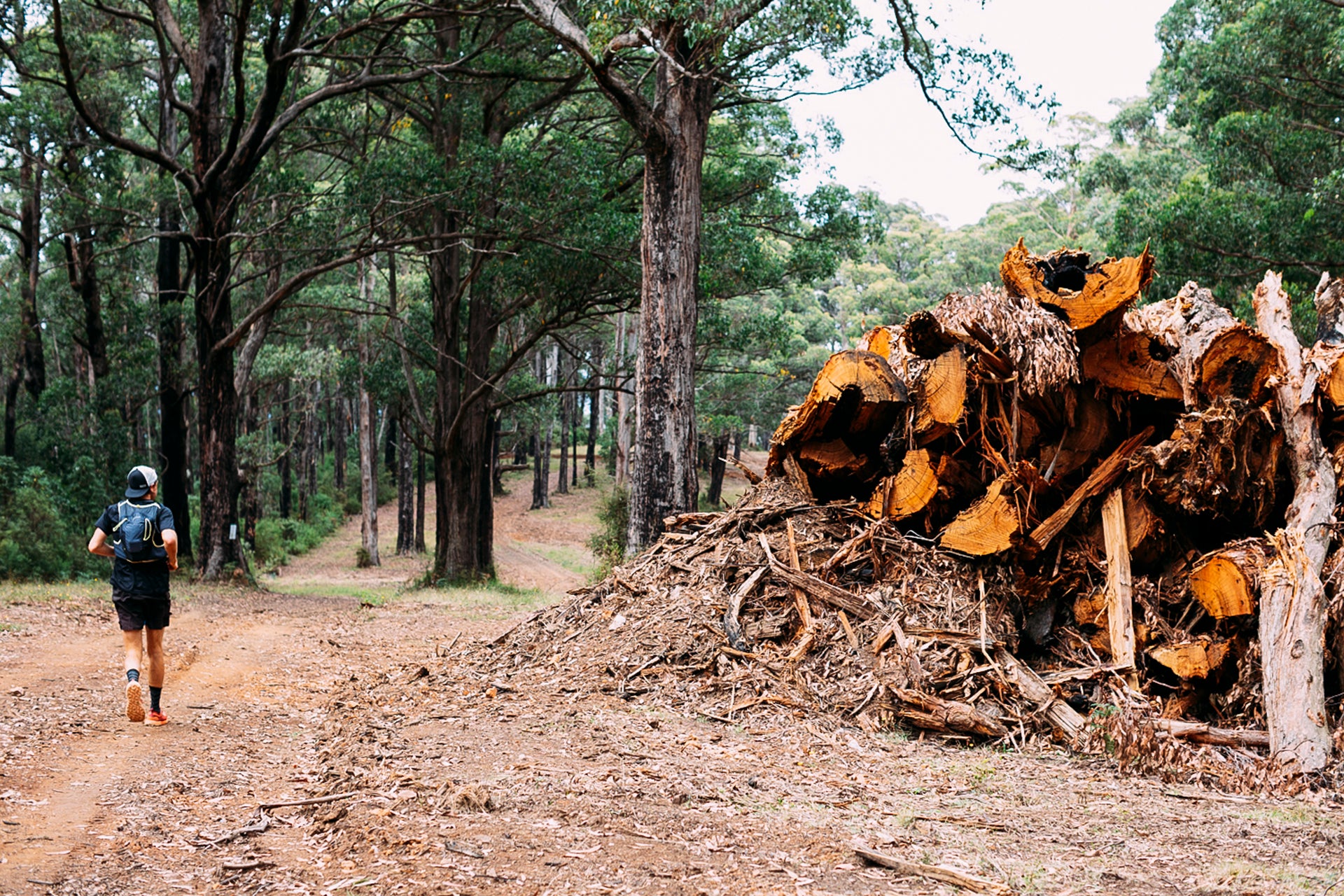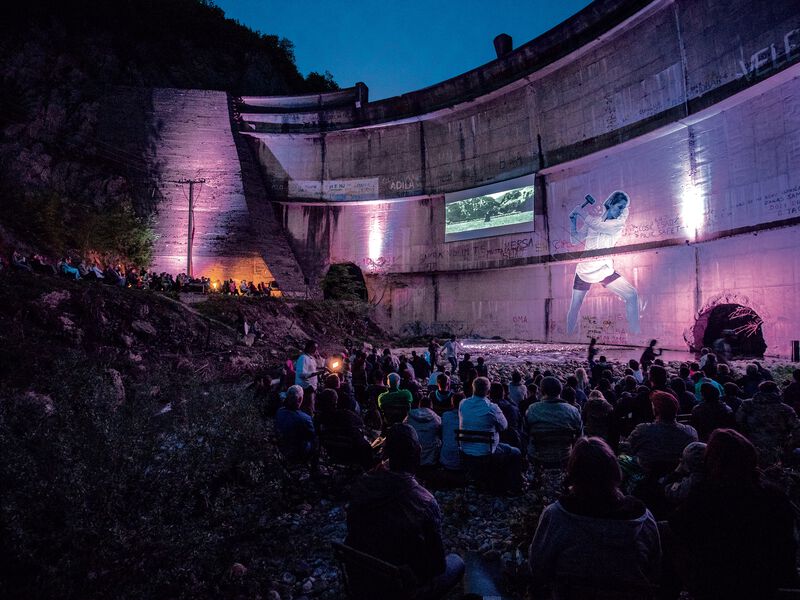History often repeats itself. It certainly seems that way in Warburton on Melbourne’s forested, northern fringe. Here, rugged, bearded men in flannelette shirts walk the streets like lumberjacks from another age. Old style shop fronts sell wooden antiques and children run freely through stands of Mountain Ash (Eucalyptus regnans), the tallest flowering plant in the world. Friends sit down and share lunch made up locally sourced produce – cheeses, wine, and sourdough bread.
All in all, it is a scene from a different era, a portrait of the quintessential timber towns of Victoria’s Central Highlands. But this is 2022 and those towns – Healesville, Warburton, Powelltown among them – are a long way from the era when native timber harvest was the key employer in the region.
Instead, the towns have transitioned and are now filled on any given weekend with trail walkers and mountain bikers keen to leave behind Melbourne’s immense urban sprawl and immerse themselves, as so many have over the years, amongst the man fern and sassafras that abound here.
But history often repeats itself in unusual ways. While the region’s economy is benefitting from people enjoying this natural landscape, just over the hill, industrial scale logging is continuing to knock it down. The irony is, compared to the halcyon years when the timber industry was providing the backbone of the state economy, native forestry is not even remotely profitable today.
Last financial year, VicForests – the agency which is responsible for managing the harvest sale, and regrowing of timber from state forests on behalf of the Victorian state government – registered a $5 million loss. The year before, it lost $7.5 million. This didn’t stop the state government providing $18 million to VicForests’ operations last year and $21 million the year before. While this is described by VicForests in a recent annual report as “other income from Victorian Government entities”, these funds are, in essence, subsidies that are allowing a loss-making enterprise to continue.
Through this, there remains a lot of confusion in the public mind about what actually happens to the trees harvested from native forests. Many assume that the timber makes its way to the local building industry to meet its voracious demand for house frames and floorboards. With housing crises across the country, demand for resources is only expected to rise.
However, demand for building timber is almost completely met by plantation stocks. And those thinking native trees feed solely the fine wood trade – turned into bespoke cabinets, tables and wardrobes – are also mistaken. The majority of native trees felled in Victoria are woodchipped or pulped and shipped offshore.
From a commercial viewpoint, logging of native timber is on its knees. Native forestry has become less and less profitable since mid-last century when thousands of workers were employed to supply timber to the sawmills of Victoria. Fast forward to 2017, and there were just 506 direct jobs associated with VicForests across the entire state.
VicForests conceded – almost a decade ago – that even in the East Gippsland Forest Management Area, Victorian forestry’s heartland, native timber harvesting operations “have not been profitable… for many years.” Such shortcomings in the current business model have helped to advance the environmental and economic cases for ending native logging in Victoria, culminating in the Victorian Labor Government announcing in 2019 that logging will be phased out over the next decade.
But for logging to limp towards this eventual finish in 2030, it has been estimated that it is going to cost Victorians $192 million in subsidies. Twenty-thirty is a significant year for environmental commitments. This ending of native forest logging sits alongside the Victorian government’s pledge to reduce carbon emissions by a full 50 percent by that year.
 “To make a road into the forest to transport cut timber from coupe to mill costs $1 million per kilometre,” says Jock Serong. “There are thousands of kilometres of these roads: VicForests gets interest-free loans from the state government to build them,” shares Professor David Lindenmayer. Photo: Cam Suttie
“To make a road into the forest to transport cut timber from coupe to mill costs $1 million per kilometre,” says Jock Serong. “There are thousands of kilometres of these roads: VicForests gets interest-free loans from the state government to build them,” shares Professor David Lindenmayer. Photo: Cam Suttie
Indeed, Lily D’Ambrosio, the state’s Minister for Energy, Environment and Climate Change, last year unveiled Victoria’s grandly named Land use, land use change and forestry sector emissions reduction pledge to help along the cutting of Victoria’s emissions between 2021 and 2025. Its two flagship elements are to restore degraded landscapes and plant “millions of new trees.” These, the Minister declared, “will not only remove emissions from the atmosphere” but deliver a range of “social, economic and environmental benefits including enhanced biodiversity, reconnection and healing of Country for Traditional Owners, improved water and air quality, and a strengthened capacity to adapt to and manage the impacts of climate change.”
Given such a commitment, the state government’s position on native logging is ambiguous to say the least.
Sections of Mountain Ash forests, such as that in Victoria which have been earmarked to be logged, have the highest known biomass carbon density in the world. Perhaps it is worth spelling out the irony – or just the sheer contradiction – of this tight rope the Victorian government is currently trying to balance on.
In other parts of the state, it pays landowners to preserve farmland and encourages schoolchildren to plant in trees and shrubs as a means to store carbon. Yet in timber regions, it is subsidising contractors to cut down some of the most carbon rich forest on earth. While the constituents of Victoria try and reconcile this, selected areas of the south east forests are literally in the firing line over the coming years, earmarked to be felled and then burnt with a substance like napalm.
This is especially significant as, in 2014, scientists declared the Mountain Ash ecosystem already at risk of collapse. Under the International Union of Conservation for Nature’s Red List of Ecosystems criteria, the ecosystem is now ranked as “Critically Endangered.”
And these forests are far more than the trees themselves. Many native fauna species which rely on the region for sanctuary are already endangered and are looking down the barrel of extinction in coming years. Those of concern include are birds such as the effervescent gang gang cockatoo, its cry like the sound of a rusty gate. For marsupials, it’s the greater glider and the tiny Leadbeater’s possum, Victoria’s faunal emblem.
With recent studies concluding that logged forests are more fire prone and fire seasons expected to worsen in a changing climate, it is a fair summation that some localised fauna populations may struggle to make it to 2030 at all.
 Our future lies in old growth forest – for water, carbon, biodiversity and fire resilience. Little will remain by the end of logging in 2030. Photo: Chris Taylor
Our future lies in old growth forest – for water, carbon, biodiversity and fire resilience. Little will remain by the end of logging in 2030. Photo: Chris Taylor
And this deadline year will no doubt be a matter of debate in the coming years given the global pivot away from land clearing. At last year’s United Nations Climate Change Conference – reported on here by Tish King from Seed mob – the overwhelming majority of countries around the world agreed to halt and reduce forest loss while “delivering sustainable development and promoting an inclusive rural transformation” by 2030. Australia was a signatory to this Agreement.
So, is there a way to utilise the value of the south eastern forests without felling them, wood chipping them and incinerating the ground where they once stood?
Perhaps. With tourism already surging and the flow on benefits of carbon management, the suggestion to amalgamate adjacent national and forest parks into one – indeed, a Great Forest National Park (GFNP) – demands to be considered.
A key report looking at the benefits of a GFNP, commissioned by the Wilderness Society in 2017, found that expanding the current reserves in the Central Highlands and Yarra Ranges – from the Whittlesea region in the west to Mt Baw Baw in the east, and from Eildon in the north to past Warburton in the south – would add more than $70 million to local economy annually.
This amalgamation, increasing the reserve system by more than 350,000 hectares, would, in the process, create 750 full time jobs through an influx of tourism and through land management ventures. Such an opportunity also presents alternative employment to assist timber workers and related businesses to rapidly exit the industry.
Whatever the Victorian government elects, one thing seems certain – the Victorian people want the tall forests as an escape. Even with the effects of the longest lockdown in the world during the height of the coronavirus pandemic last year, having the highlands on the doorstep of Melbourne resulted in people spending close to half a billion dollars on overnight and day trips in the region.
In places where the land was once clear-felled, people have spent the last year travelling across the state to see the bird and plant species of these significant rainforest systems, to travel along the famous Black Spur and to fish, camp and walk the area from the Cathedral Range to the Toolangi pass as people have for so many years.
It remains to be seen which history the Victorian government will choose to repeat.
End native forest logging and support the creation of the Great Forest National Park in Victoria. Learn more here.
Find out where your local candidate stands on this issue at Victorian Forest Alliance.





